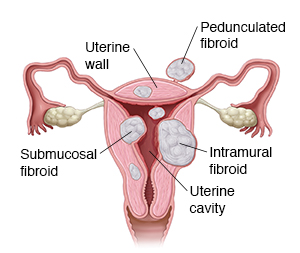What Are Fibroids?
What Are Fibroids?

Types of fibroids include:
Pedunculated. These are connected to the uterine wall by stalks.
Submucosal. These grow from the uterine wall into the uterine cavity.
Intramural. These grow inside the uterine wall.
Possible problems
Fibroids often cause no symptoms. But a fibroid that grows quickly in your uterus can cause 1 or more of the following problems:
Excessive uterine bleeding, leading to a lack of red blood cells (anemia)
Frequent urge to urinate
Trouble having bowel movements
Achiness, heaviness, or fullness
Back or belly (abdominal) pain
Pain during sex
Trouble getting pregnant or being unable to get pregnant
Problems with pregnancy
Enlargement of the lower abdomen
Treatment is tailored for you
No 2 fibroids are the same. The type of treatment you will have depends on several things including:
How many fibroids you have, their size, location, and how fast they grow
How severe your symptoms are
If you plan to have children in the future
There are a growing number of effective ways to treat fibroids. After your medical evaluation, your healthcare provider will talk with you about the best options to solve your particular problem and meet your needs.
Your future checkups
Treating your fibroids is likely to relieve your symptoms. But your healthcare provider will want to check your progress. Ask your provider about any other follow-up visits you might need.
Updated:
March 30, 2018
Sources:
Bulun S. Uterine Fibroids. New England Journal of Medicine. 2013;369(14):1344.
Reviewed By:
Burd, Irina, MD, PhD,Goode, Paula, RN, BSN, MSN,Image reviewed by StayWell medical illustration team.